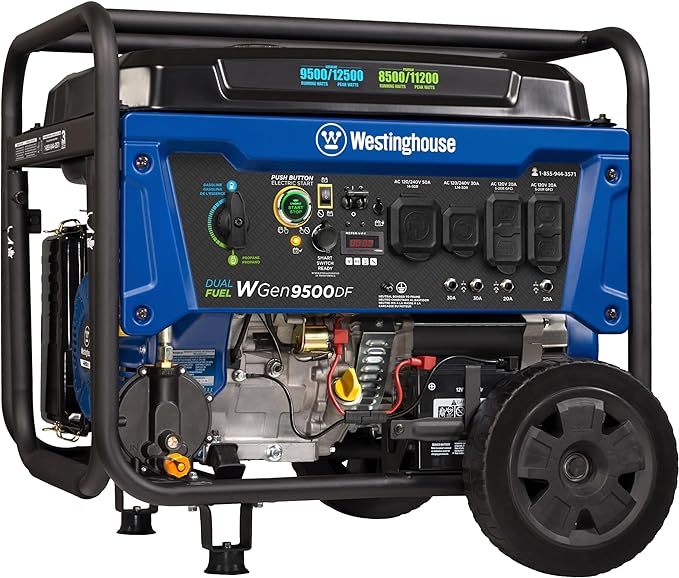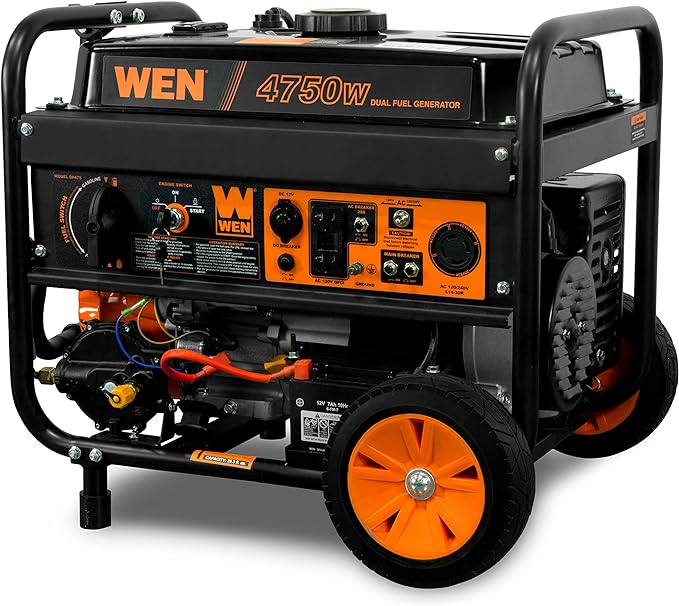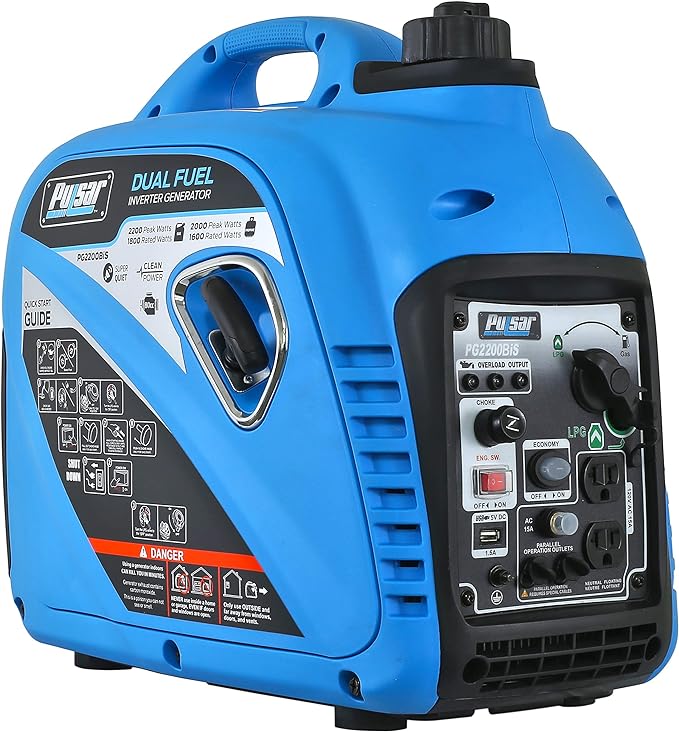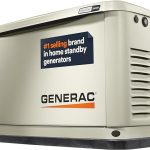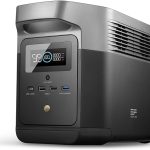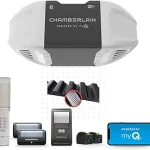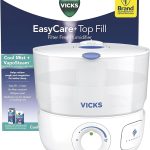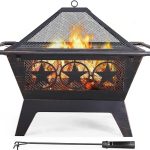When it comes to choosing a reliable power source, you’re likely evaluating a dual-fuel generator. But with so many options available, where do you start? You’ll want to narrow down your search to the top performers that meet your specific needs. That’s why we’ve identified the four best dual-fuel generators on the market, each offering unique benefits and features. From power output and fuel types to portability and noise levels, there’s a lot to weigh. Let’s take a closer look at what sets these generators apart and how to determine which one is right for you.
Contents
Westinghouse Dual Fuel Home Backup Portable Generator
The Westinghouse Dual Fuel Home Backup Portable Generator is an excellent choice if you’re looking for a reliable backup power source that can handle high-wattage appliances, thanks to its ability to produce up to 12,500 peak watts and 9,500 running watts.
This dual-fuel generator operates on either gasoline or propane, giving you flexibility and convenience.
With its heavy-duty 457cc 4-Stroke OHV Westinghouse Engine, you can expect a runtime of up to 12 hours on a 6.6-gallon gas tank.
You’ll appreciate the built-in fuel gauge, automatic low oil shutdown, and GFCI outlets for added safety.
Plus, the push-button electric start and remote start key fob make it easy to get up and running quickly.
Best For: Homeowners who need a reliable backup power source to handle high-wattage appliances and critical circuits in their homes.
Pros:
- Produces up to 12,500 peak watts and 9,500 running watts, making it suitable for powering high-wattage appliances
- Dual fuel capability allows for flexibility and convenience, operating on either gasoline or propane
- Features a heavy-duty 457cc 4-Stroke OHV Westinghouse Engine for reliable performance and a runtime of up to 12 hours on a 6.6-gallon gas tank
Cons:
- Weighs 210 pounds, making it heavy and potentially difficult to transport
- Has a high sound level of 74 dB, which may be disturbing in residential areas
- Requires a 12V battery, which may need to be replaced periodically
DuroMax XP13000EH Dual Fuel Portable Generator
The DuroMax XP13000EH Dual Fuel Portable Generator is a powerful, flexible, and durable option for those who need to keep their entire home running during a storm or power outage.
With its 13,000 watts of power and dual fuel technology, this generator offers flexibility in fuel type.
The robust generator is designed to provide reliable power, featuring a heavy-duty all-metal frame and power panel with no plastic parts.
The variety of outlets, including a transfer switch-ready 50-amp outlet, and the push-button start and front-facing interface for easy fuel type changes make it a convenient option.
The no-flat tires make moving the generator around a breeze.
Best For: Those who need a powerful and flexible generator to keep their entire home running during a storm or power outage.
Pros:
- Robust and durable design with a heavy-duty all-metal frame and power panel with no plastic parts
- Provides 13,000 watts of power and dual fuel technology for flexibility in fuel type
- Excellent customer service and tech support
Cons:
- Instructions lack clarity and critical information, especially for propane use
- Generator stalls on propane when in low idle mode
- Lack of information on fuel valve switch and choke operation
WEN DF475T Portable Generator with Electric Start
The WEN DF475T Portable Generator with Electric Start is a top choice for homeowners seeking a reliable and versatile power source.
It offers dual-fuel capability and an impressive 11-hour runtime at half load.
The convenience of electric start eliminates the need for manual pull-starting.
This generator is designed to provide power for your home, with a 4750-watt output and a range of outlet options, including two 120V GFCI outlets and a 120V/240V NEMA 30A twist lock.
With its 4-gallon tank and dual-fuel capability, you can choose between gasoline and propane to keep your lights on and your appliances running.
Best For: Homeowners seeking a reliable and versatile power source for their homes.
Pros:
- Dual-fuel capability allows for flexibility and convenience in fuel choices
- Electric start eliminates the need for manual pull-starting, making it easy to get started
- Impressive 11-hour runtime at half load provides reliable power for an extended period
Cons:
- Some reviewers have reported issues with shipping damage or missing parts
- Weighing 105.8 pounds, the generator may be difficult to move or transport
- No specific noise level rating is provided, which may be a concern for some users
Pulsar Portable Dual Fuel Quiet Inverter Generator
Frequent campers and homeowners seeking a reliable backup power source will appreciate the Pulsar Portable Dual Fuel Quiet Inverter Generator, which offers a unique combination of quiet operation, compact design, and versatile fuel options.
You’ll appreciate its ability to run on either gasoline or LPG, providing you with flexibility in emergency situations.
With a peak wattage of 2,200 on gasoline and 2,000 on LPG, you’ll have enough power to run essential appliances.
Weighing only 44 pounds and featuring a compact carrying case design, you can easily take it with you on camping trips or store it in your garage.
Its quiet operation, producing only 60 decibels, guarantees a peaceful experience.
Best For: Frequent campers and homeowners seeking a reliable backup power source.
Pros:
- Quiet operation producing only 60 decibels for a peaceful experience
- Compact design and lightweight (44 pounds) for easy portability
- Versatile fuel options with the ability to run on either gasoline or LPG
Cons:
- Limited fuel tank capacity of 1.18 gallons, requiring more frequent refueling
- Relatively short run-time of 8 hours on a single tank of gas
- No explicit mention of a battery or electric start option
Factors to Consider When Choosing Dual-Fuel Generators
When selecting a dual-fuel generator, you’ll want to ponder several key factors to guarantee you get the right one for your needs.
You’ll need to think about your power output needs, the type of fuel you want to use, and how much noise you’re willing to tolerate.
Power Output Needs
You’ll need to determine your power output needs by calculating the total wattage of all appliances and devices that will be powered simultaneously. This will give you an idea of the minimum power output required from your dual-fuel generator.
Don’t forget to add a buffer for surge capacity and future expansion to avoid overload and guarantee safe operation.
Dual-fuel generators can offer a range of power output options, from 2,200 to 12,500 peak watts. A higher power output can provide more flexibility and versatility, but it may also increase the weight, size, and cost of the generator.
Consider the type and number of outlets on the generator, as some may have multiple 120V outlets, 240V outlets, or USB ports to accommodate different types of devices.
When choosing a dual-fuel generator, it’s vital to verify that the power output meets or exceeds your total wattage requirement.
This will prevent overload and guarantee safe operation. By calculating your power output needs, you’ll be able to select a generator that can handle your appliances and devices, providing you with reliable power when you need it most.
Fuel Type Options
With dual-fuel generators, you have the flexibility to choose between gasoline and propane (LPG) as your fuel source, depending on what’s available, cost-effective, and suits your personal preferences.
This flexibility is a significant advantage, as you can opt for the fuel that’s most convenient for your situation. Gasoline is a more traditional fuel source, but it can degrade over time, affecting the generator’s performance.
On the other hand, propane is a cleaner-burning fuel that’s less prone to degradation. If you’re looking for a fuel that’s ideal for emergency power backup systems, propane is often the preferred choice due to its longer shelf life and lower maintenance requirements.
When switching between gasoline and propane, you might need to make some adjustments. For instance, some generators, like the DuroMax XP13000EH, require a spark plug change when switching between the two fuels.
Additionally, don’t forget to turn on the fuel valve switch, regardless of the fuel type you’re using. By considering these factors, you’ll be able to choose the right fuel type for your dual-fuel generator and guarantee it runs efficiently and effectively.
Noise Level Concerns
As you weigh your options for a dual-fuel generator, consider the surrounding environment and the noise level tolerance you need to guarantee minimal disturbance. You don’t want to disturb your neighbors or disrupt your own peace and quiet.
When selecting a dual-fuel generator, verify that you check the noise level specifications to guarantee it meets the requirements of your intended use.
Some generators can produce noise levels exceeding 80 dB, which may be disturbing in certain environments. However, there are quieter options available.
For instance, the Pulsar Portable Dual Fuel Quiet Inverter Generator operates at a noise level of 60 dB, making it suitable for quiet neighborhoods. The Westinghouse WGen9500DF Dual Fuel Portable Generator is another option, with a relatively quiet operation of 74 dB.
When choosing a dual-fuel generator, consider the noise level tolerance of your intended use. If you plan to use it for camping, RVing, or in residential areas, look for generators with lower decibel ratings.
Portability Features
When you’re selecting a dual-fuel generator, portability features become vital considerations, since they can profoundly impact the device’s overall usability and convenience.
You’ll want to weigh the weight and size of the generator, as some models can be surprisingly lightweight and compact, weighing as little as 44 pounds and measuring 19.7L x 11.22W x 17.91H in dimensions.
No-flat tires can provide easy movement over various terrains, and a compact carrying case design can facilitate convenient storage and transport.
However, you should also keep in mind that some generators can be heavy, like 210 pounds, and may require additional manpower or equipment to relocate.
Fortunately, some models come with a wheel and handle kit, which can greatly enhance their portability, allowing you to easily maneuver the device around job sites or campsites.
Ultimately, the overall size and weight of a dual-fuel generator will impact its suitability for different applications, such as camping or residential backup power, and should be carefully evaluated during the selection process.
Warranty Support
You should carefully evaluate the warranty support offered by different manufacturers before making a purchase, as it can substantially impact your overall satisfaction with your dual-fuel generator.
A good warranty can provide peace of mind and protect your investment.
When researching dual-fuel generators, look for manufacturers that offer extensive warranties and reliable customer support.
For instance, Westinghouse offers a 3-year limited warranty and lifetime technical support, giving you confidence in their products.
DuroMax is known for its excellent customer service, with friendly and responsive representatives who can help you troubleshoot issues.
WEN provides a 2-year warranty, backed by a nationwide network of skilled technicians and customer support.
Pulsar’s warranty terms are available upon request, and they also have a price-matching mechanism in place.
Remember to review the warranty terms and conditions carefully before making a purchase, so you understand the level of support and protection offered by the manufacturer.
Frequently Asked Questions
Can I Use a Dual-Fuel Generator in High-Altitude Areas?
You’re wondering if you can use a dual-fuel generator in high-altitude areas. Yes, you can, but you’ll need to derate the generator’s power output according to the manufacturer’s high-altitude derating chart to guarantee safe operation.
Do Dual-Fuel Generators Require More Maintenance Than Single-Fuel?
As you weigh the pros and cons of dual-fuel generators, a question lingers: do they demand more TLC than their single-fuel counterparts? Truth is, you’ll need to perform routine checks on spark plugs, oil, and air filters, but it’s not a Herculean task.
Are Dual-Fuel Generators Suitable for Indoor Use?
You’re wondering if dual-fuel generators are suitable for indoor use. Generally, it’s not recommended due to carbon monoxide risks and ventilation concerns. You should always prioritize safety and use them outdoors, away from windows and doors.
Can I Convert a Single-Fuel Generator to Dual-Fuel?
As you stand at the crossroads of generator conversions, wondering if you can breathe new life into your single-fuel machine, the answer is a resounding maybe – it’s possible, but it’s a complex, potentially costly endeavour that requires expert hands.
Do Dual-Fuel Generators Offer Better Fuel Efficiency?
You’re wondering if dual-fuel generators offer better fuel efficiency? Well, they can, since you can switch between fuels to optimize efficiency based on your needs, but it depends on the specific model and your usage.
Conclusion
You’ve narrowed down your options to the top four dual-fuel generators on the market.
Now, it’s time to make your move.
Will you opt for the Westinghouse’s reliability, the DuroMax’s raw power, the WEN’s electric start convenience, or the Pulsar’s whisper-quiet operation?
The decision is yours, but remember, the right choice will keep your lights on, your food fresh, and your family safe when the grid goes dark.
Choose wisely, and you’ll be ready for whatever Mother Nature throws your way.
